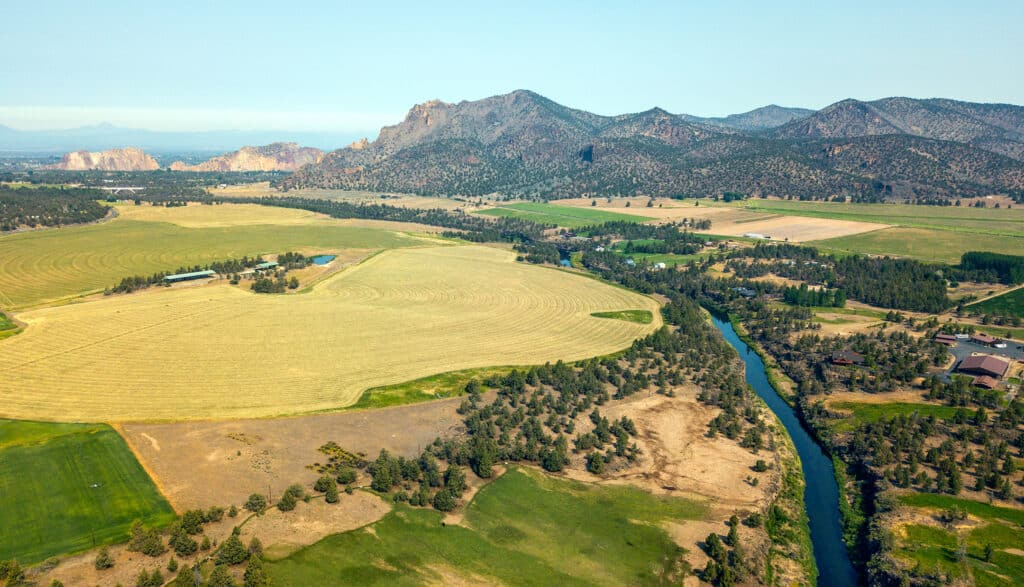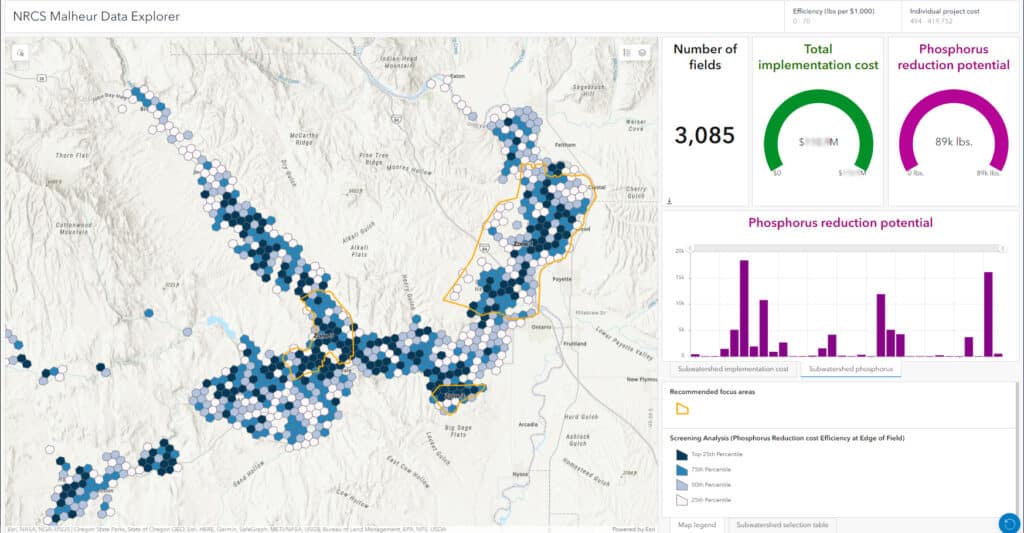Strategic Conservation Investments in Oregon Supported by TFT Analytics
November 9, 2023
The Inflation Reduction Act (IRA) added $19 billion to U.S. Department of Agriculture (USDA) conservation programs. This momentous investment has heightened the already pressing need to quickly and effectively deliver conservation funds to high-impact projects.
Through an innovative agreement with the Oregon Natural Resources Conservation Service (NRCS), a division of the USDA, The Freshwater Trust (TFT) will provide Oregon NRCS staff with the tools and insight to evaluate and help prioritize irrigation-system improvement investments in agricultural areas of central and eastern Oregon.
“With partners like NRCS, we can apply 21st century technology to drive conservation dollars to the actions and places that produce results,” said David Primozich, Vice President of Water at TFT.
NRCS Oregon already uses a strategic approach to conservation. The analytical tools provided by TFT will enable NRCS to more precisely deliver conservation dollars to agricultural producers as part of its locally led Conservation Implementation Strategies (CIS) approach. TFT’s tools will help resource conservation managers increase agricultural water management flexibility in the face of drought and achieve water quality improvements, while maximizing outcomes for tribes, conservation partners, and recreational users of rivers.

The first stage of analysis, recently completed, assessed the cost and water quality benefits of potential field-level irrigation modernization projects within the Oregon NRCS CIS priority agricultural areas in the Deschutes, Malheur and Owyhee River basins. Upgrading irrigation systems helps producers better manage their operations in the face of water scarcity and reduces agricultural runoff from fields into local rivers.
To do this work, TFT is using its BasinScout® toolkit, an integrated modeling system that supports cost-benefit analyses of NRCS practice implementation, including sprinkler systems, high-efficiency irrigation or microirrigation, and irrigation pipelines. BasinScout starts with a coarse-scale screening assessment that highlights opportunity areas where edge-of-field runoff is greatest.
“Our agreement with The Freshwater Trust provides us with a crucial analytics tool to be strategic in using Farm Bill and IRA funds to aid agricultural producers with the implementation of conservation actions that address SWAPA-H (soil, water, air, plant, animal and human) issues,” said Damon Brosnan, Assistant State Conservationist for Field Operations at NRCS Oregon.
With the basin-scale opportunity assessments complete, TFT is next working with NRCS staff to identify specific areas within these geographies to complete higher resolution analyses that can be used for program planning and proactive recruitment of a collection of specific projects.
The goal is to rapidly provide NRCS staff and regional partners with the information they need to prioritize and plan projects that maximize environmental benefits for the lowest cost.
In practice, in Oregon’s Malheur Basin, 3,085 fields could be converted to a new irrigation practice, resulting in 89,000 pounds of total phosphorus reduction. BasinScout’s heatmap highlights areas (shown in darker blue) with higher efficiency phosphorus reduction potential (e.g., fields that can reduce loads most cost-effectively). With guidance and feedback from NRCS, clusters will be identified for more targeted analysis. The overall goal is to identify a subset of the fields that can yield the most cost-efficient results. (Field characteristics are anonymized in this tool to protect producer confidentiality.)

The geospatial analysis of the Malheur River basin highlights efficient phosphorus reductions. Efficiency is calculated as the amount of the phosphorus load from a field that can be reduced with a more efficient irrigation system divided by the cost of installing that system.
Developing and using these tools is especially important as Oregon NRCS receives historic funding levels from the IRA. Due to this rapid increase in available funds, more money must move more quickly to more projects. TFT’s BasinScout tool helps enable that outcome, which is a win for the agency, agricultural producers, and the environment.
“Our partners have clear objectives to make every conservation dollar count,” said Primozich.
“We’re helping them identify practices that have a positive impact on regional water quality—as well as the most effective and efficient locations for implementing those practices.”
“To aid us in the obligation and implementation of conservation dollars, NRCS must look to the future and use modern tools to help us to be the most strategic and helpful to our customers, the private landowners of Oregon,” said Brosnan.
—–
Any reference to specific brands or types of products or services does not constitute or imply an endorsement by the U.S. Department of Agriculture for those products or services.
#agriculture #BasinScout #Deschutes River #Eastern Oregon #irrigation systems #NRCS #U.S. Department of Agriculture
